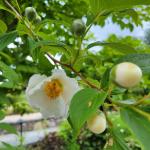UMass Extension's Landscape Message is an educational newsletter intended to inform and guide Massachusetts Green Industry professionals in the management of our collective landscape. Detailed reports from scouts and Extension specialists on growing conditions, pest activity, and cultural practices for the management of woody ornamentals, trees, and turf are regular features. The following issue has been updated to provide timely management information and the latest regional news and environmental data.
The Landscape Message will be updated twice in July. The next message will be posted on July 8. To receive immediate notification when the next Landscape Message update is posted, be sure to join our e-mail list
To read individual sections of the message, click on the section headings below to expand the content:
Scouting Information by Region
Environmental Data
The following data was collected on or about June 22, 2022. Total accumulated growing degree days (GDD) represent the heating units above a 50º F baseline temperature collected via regional NEWA stations (http://newa.cornell.edu) for the 2022 calendar year. This information is intended for use as a guide for monitoring the developmental stages of pests in your location and planning management strategies accordingly.
|
MA Region/Location |
GDD |
Soil Temp |
Precipitation |
Time/Date of Readings |
|||||
|
1-Week Gain |
2022 Total |
Sun |
Shade |
||||||
|
CAPE |
91 |
599 |
67 |
62 |
0.11 |
12:00 PM 6/22 |
|||
|
SOUTHEAST |
92.5 |
711 |
77 |
64 |
0.20 |
3:00 PM 6/22 |
|||
|
NORTH SHORE |
86 |
625 |
67 |
59 |
0.15 |
9:00 AM 6/22 |
|||
|
EAST |
101 |
778 |
71 |
67 |
0.30 |
5:00 PM 6/22 |
|||
|
METRO |
96 |
734 |
63 |
59 |
0.18 |
5:45 AM 6/22 |
|||
|
CENTRAL |
93 |
721 |
68 |
62 |
0.46 |
1:00 PM 6/22 |
|||
|
PIONEER VALLEY |
93.5 |
756 |
66 |
61 |
0.35 |
5:00 PM 6/22 |
|||
|
BERKSHIRES |
69 |
597 |
65 |
59 |
0.44 |
9:00 AM 6/22 |
|||
|
AVERAGE |
90 |
690 |
68 |
61.5 |
0.27 |
_ |
|||
|
* = information not available |
|||||||||
Dry conditions worsen; as of 6/21, almost the whole state is either classified as "Abnormally Dry" or in a "Moderate Drought": Massachusetts | U.S. Drought Monitor (unl.edu)
Phenology
| Indicator Plants - Stages of Flowering (BEGIN, BEGIN/FULL, FULL, FULL/END, END) | ||||||||
|---|---|---|---|---|---|---|---|---|
| PLANT NAME (Botanic / Common) | CAPE | S.E. | N.S. | EAST | METRO W. | CENT. | P.V. | BERK. |
|
Hydrangea macrophylla (bigleaf hydrangea) |
Begin |
Begin |
* |
* |
* |
Begin |
Begin |
* |
|
Hydrangea arborescens (smooth hydrangea) |
Begin |
Full |
Begin |
* |
* |
Begin |
Begin |
* |
|
Itea virginica (Virginia sweetspire) |
Begin |
Full |
Begin/Full |
Begin/Full |
Begin/Full |
Begin/Full |
Begin |
Begin |
|
Rhus typhina (staghorn sumac) |
Begin/Full |
Full |
Begin |
Begin |
Begin |
Begin |
* |
Begin |
|
Tilia cordata (littleleaf linden) |
Full |
Full/End |
Full |
Full |
Full |
Begin/Full |
Full |
* |
|
Sambucus canadensis (American elderberry) |
Begin |
Full |
Full |
Full |
Full |
Full |
Full |
Begin/Full |
|
Ligustrum spp. (privet) |
Full |
Full/End |
Full |
Full |
Full |
Full |
Full |
Full |
|
Catalpa speciosa (northern catalpa) |
Begin/Full |
Full/End |
Full |
Full |
Full |
Full/End |
Full |
Full |
|
Kalmia latifolia (mountain laurel) |
Full |
End |
Full/End |
Full/End |
Full/End |
Full/End |
End |
Full/End |
| * = no activity to report/information not available | ||||||||
Regional Notes
Cape Cod Region (Barnstable)
General Conditions: The average temperature for the period from June 15 – June 22 was 62°F with a low of 47°F on June 20 and a high of 77°F on June 17. In general highs in the 70s with lows near 60ᣞF. The period had a good mix of cloudy, partly cloudy and sunny days. Approximately one tenth an inch of precipitation fell on June 19. Soil moisture is short. Some herbaceous plants seen in bloom include rose campion (Lychnis coronaria), Coreopsis spp., blue false indigo (Baptisia australis), garden loosestrife (Lysimachia vulgaris), catmint (Nepeta spp.), wood sage (Salvia sylvestris), oxeye daisy (Leucanthemum vulgare) and daylily (Hemerocallis spp.). Some woody plants seen in bloom include Kousa dogwood (Cornus kousa), American holly (Ilex opaca), arrowwood (Viburnum dentatum), roses (Rosa spp.), oakleaf hydrangea (Hydrangea quercifolia), and Japanese spirea (Spiraea japonica).
Pests/Problems: Beech leaf disease has been reported from several locations in the upper Cape. A few adult Japanese and Asiatic beetles have been seen during the period, turpentine beetle is active, roseslug sawfly damage was observed on rose, viburnum leaf beetle damage observed on arrowwood viburnum, leaf miner damage on daylily and columbine, eriophyid mites were observed on several woody species, earwig and slug damage is being observed on herbaceous plants. Disease symptoms or signs observed during the period include needlecast on pitch pine, tip blight and branch dieback on Leyland cypress, anthracnose on sycamore, brown rot on ornamental cherries, exobasidium gall on azalea, black spot on rose, apple scab on crabapple, powdery mildew on smokebush, and red thread on turf. Weeds and invasive plants in bloom include sheep sorrel (Rumex acetosella), white clover (Trifolium repens), red clover (Trifolium pratense), bird’sfoot trefoil (Lotus corniculatus), narrowleaf plantain (Plantago lanceolata), yellow hawkweed (Hieracium pratense), chicory (Cichorium intybus), sheep’s-bit (Jasione montana), catsear (Hypochaeris radicata), black medic (Medicago lupulina), black swallowwort (Cynanchum louiseae) and multiflora rose (Rosa multiflora). Ticks are everywhere – keep yourself protected.
Southeast Region (Dighton)
General Conditions: Weather for the week was dry and comfortable with some mornings starting out almost sweater chilly. Friday, June 17th, saw the high temperature of the week at 80°F. We also received 0.11 inches of rain. Saturday, June 18th, was markedly cooler with a high temperature of 71°F, while the low was 55°F. Cool weather continued into Sunday, June 19th, which reached only 61°F and a low of 50°F. We also had 0.09 inches of precipitation. June 20th and 21st had the lowest night time lows of the reporting week at 46°F. In addition to species listed in the above phenology chart, plants seen in flower include: Ailanthus altissima (tree of heaven), Aruncus dioicus (goat's beard), Asclepias incarnata (swamp milkweed), A. syriaca (common milkweed), Astilbe (false goat's beard), Cichorium intybus (chicory), Clematis (leather vine), Cornus kousa (Chinese dogwood), C. racemosa (gray dogwood), Coreopsis (tickseed), Dacus carota (queen Anne's lace, wild carrot), Dicentra formosa (western bleeding heart), Digitalis lutea (yellow perennial foxglove), D. purpurea (biennial foxglove), Echinacea spp. (coneflower), Hemerocallis fulva (orange daylily), H. 'Stella d'oro' (early yellow daylily), Hosta spp. (plantain lily), H. paniculata (panicled hydrangea), Hypercium densiflorum (St. John's wort), Ilex glabra (inkberry holly), I. verticulata (winterberry holly), Lathyrus latifolius (perennial sweet pea), Leucanthemum vulgare (oxeye daisy), L. x superbum (Shasta daisy), Leucothoe axillaris (coastal leucothoe), Lonicera sempervirens (coral honeysuckle), Lotus corniculatus (bird's foot trefoil), Lysimachia punctata (spotted loosestrife), Nepta (catnip), Nymphaea (water lily), Oenothera fruticosa (sundrop), Penstemon hirsutus (hairy beardtongue), Phlox paniculata (garden phlox), Rhododendron mollis (deciduous azalea), Salvia yangii (Russian sage), Silene coronaria (rose campion), Spirea japonica (Japanese meadowsweet), Syringa reticulata (Japanese tree lilac), Tradescantia (spiderwort), Verbascum thapsus (great mullein), Viburnum x carlcephalum (fragrant snowball), and Vicia villosa (hairy vetch).
Pests/Problems: Yellow nutsedge (Cyperus esculentus) is becoming obvious in residential turf where it's established. Ticks remain a constant concern while working in the brush. Dry conditions continue to plague us. (See the Drought Monitor link just below the Environmental Data chart.)
North Shore (Beverly)
General Conditions: Temperatures during this reporting week (June 16 -23) were in the mid 60s to mid 70s during the day at Long Hill in Beverly. Most days were sunny with clear skies. Night temperatures were in the mid 40s to mid 50s. The average daily temperature was 62ºF with the maximum temperature of 86ºF recorded on June 17 and the minimum night temperature of 45ºF recorded on June 21. Little precipitation was received during this period. Approximately 0.15 inches of rain was recorded at Long Hill during this period. We need more rain before plants start to experience moisture stress. In addition to those in the Phenology Table above, woody plants seen in bloom include: tall stewartia (Stewartia monadelpha), Japanese tree lilac (Syringa reticulata), Peking tree lilac (Syringa pekinensis), tulip tree (Liriodendron tulipifera), Kousa dogwood (Cornus kousa), Japanese hydrangea vine (Schizophragma hydrangeoides), and Carolina allspice (Calycanthus floridus). Herbaceous plants in bloom include: white clematis (Clematis paniculata), Virginia rose (Rosa virginiana), garden roses (Rosa spp.), blue false indigo (Baptisia australis), catmint (Nepeta spp.), goat’s beard (Aruncus dioicus), yellow corydalis (Corydalis lutea), ornamental onions (Allium spp.), water lily (Nymphaea spp.), oxeye daisy (Leucanthemum vulgare) and many other perennials and annual plants.
Pests/Problems: Lilac leafminer (Caloptilia syringella) was observed on some lilacs. The lilac leafminer larvae produce a blotch mine on the foliage and when older they roll and tie the leaf with silk. The larvae and adults continue to feed on the leaves from within the tied leaf. Lilac leafminers do not cause a lot of damage because they typically only infest a few leaves.. Plum web-spinning sawfly (Neurotoma inconspicua) continues to cause damage on beach plum (Prunus maritima). Iron deficiency symptoms were observed on azalea, blueberry and some other plants. Iron deficiency occurs on acid loving plants when soil pH is above 6.2 and it shows up as interveinal chlorosis ( yellowing between veins). Iron deficiency can be corrected by applying acid fertilizers such as ammonium sulfate or applying elemental sulfur.
East Region (Boston)
General Conditions: Summer arrived this past week with an average daily temperature of 74°F. The morning temperature on June 20th was 45°F. As of June 20, 2021, we had received one 89°F day. We had one day nearing 90°F in May, but none reaching 90°F thus far in 2022. We received 0.29 inches of beneficial precipitation on the 19th far short of what is needed. The very fragrant, native, Magnolia virginiana (sweet bay magnolia) is flowering. There is an abundance of snack worthy Amelanchier spp. (shadbush) fruit throughout the landscape.
Pests/Problems: Lack of soil moisture continues to be a concern. There is an abundance of aphid activity on birches and oaks. Digitaria spp. (crabgrass) is filling in vacancies in unmanaged turf and unmulched sunny borders. The difficult to control Convolvulus arvensis (field bindweed) is aggressively attacking plants in areas where it is established.
Metro West (Acton)
General Conditions: We welcomed the summer season with this week’s report. Moderate if not cool temperatures and windy days prevailed throughout the past week. A day time high temperature of 64°F was recorded on the 19th and a night time low of 45°F was recorded on the 20th. For the week, the highest temperature of 88°F was recorded on the 17th. On Saturday, the 18th, wind gusts were recorded up to 24 mph. The historical monthly average rainfall for June is 3.93” and as of the 22nd, 1.60” of rain has been recorded for this month so far. Hopefully there will be more precipitation to come over the remaining days of the month to close this gap. In addition to the status of the species in the above Phenology table, the following woody plants were observed in some stage of bloom this past week: Cornus kousa (Kousa dogwood), Hydrangea quercifolia (oakleaf hydrangea), Oxydendrum arboreum (sourwood), Potentilla fruticosa (potentilla), Spiraea japonica 'Alpina' (daphne spirea), and Stewartia pseudocamellia (Japanese stewartia). Contributing even more color and interest to the landscape are some flowering herbaceous plants including: Aruncus aethusifolius (dwarf goat’s beard), A. dioicus (goat’s beard), Baptisia australis (blue false indigo), Campanula takesimana ‘Elizabeth’ (bell flower), Digitalis purpurea (foxglove), Geranium ‘Johnson’s Blue’ (cranesbill), G. sanguineum (bloody cranesbill), Hemerocallis spp. (daylily), Hemerocallis fulva (orange daylily), Heuchera spp. (coral bells), Hosta spp. (plantain lily), Leucanthemum sp. (shasta daisy), Lilium spp. (lily), Lychnis coronaria (rose campion), Penstemon digitalis 'Husker Red' (beardtongue), Salvia nemorosa (salvia), Sedum kamtschaticum (Russian stonecrop), Stachys byzantina (lamb’s ear), and Thymus praecox (thyme).
Pests/Problems: Despite the recent rain, recorded precipitation is well below average levels. As of June 7th, the “abnormally dry conditions” status remained in effect for this area. (See the Drought Monitor link just below the Environmental Data chart.) Signs of stress are apparent on trees with premature leaf drop on Betula spp. (birch) and Malus spp. (crabapple, apple). Observed in the landscape this past week was the dieback on many Pinus strobus (white pine).
Central Region (Boylston)
General Conditions: Happy summer! This reporting period felt more like spring, with unseasonably cool temperatures and a low of 44°F. The high temperature for the week was 83°F on June 17, but other than one day of seasonable warmth, it barely felt like the start of summer. The garden definitely has a lot of color and interest at the moment. Many of our early summer blooming trees and shrubs are coming into their own. Hydrangea quercifolia (oakleaf hydrangea) is in its early blooming stages, as is Hydrangea arborescens (smooth hydrangea). Stewartia pseudocamellia (Japanese stewartia) is just starting to open. With exfoliating bark, outstanding fall color, and white flowers with yellow centers in early- to mid-summer, this small flowering tree is a great choice for smaller gardens (see photos).
Pests/Problems: As of June 14, there has been no change from the previous reporting period in our drought status. We continue to see very little precipitation, although the cooler temperatures are tempering the effect of dry conditions. To date, since April 1, we’ve only received about 6 inches of rainfall, far below the expected average of about 10 inches by this time in the growing season. As temperatures warm, if this pattern continues, we will see further signs of drought stress throughout the landscape. No other significant pest or disease issues were noted at this time.
Pioneer Valley Region (Amherst)
General Conditions: Summer has officially arrived with the passing of the solstice, but we’ve been deep in the summer growing season for weeks now. The pattern of mild weather continued over the past week in the Pioneer Valley, but also included scattered storms and strong winds. It was warmer and humid on 6/17 with isolated and powerful storms that tracked from NW to SE. The UMass campus was hammered with rain, accumulating almost an inch in less than an hour. However, many other locations in the valley received zero to minor accumulations. The mild June has extended the growing season and bloom for many plants, a welcome occurrence after back-to-back years of sweltering June weather (2020 and 2021). Cool and windy conditions dominated the weekend of 6/18–19, with high temperatures peaking at only 65°F on 6/18 and wind gusts >35 mph on 6/19. There was scattered limb breakage and some landscape plants were damaged, like panicle hydrangea. Additional rainfall was taking place at the time of writing on 6/22, but once again, paltry amounts were observed in the rain gauge. Many landscapes in Hampshire County are dry and the number of browning lawns is increasing. For plants under irrigation with indeterminate growth rates, like Japanese maple, kousa dogwood, redbud, and eastern hemlock, new growth continues to accrue.
Pests/Problems: More leaf spots, blotches and anthracnose infections are appearing but overall, the dry conditions have helped to suppress foliar disease fungi. However, the recent rainfall, albeit light in accumulation, and mild temperatures could change that narrative. Symptoms of Dutch elm disease are appearing on infected trees with browning leaves and canopy dieback. White pine needle shedding continues but is decreasing as many of the older, diseased needles have already been lost. Canopies may appear very thin at this time while the current season’s growth continues to elongate. Japanese beetles on roses were observed but populations are still low at this time. These invasive pests often become more abundant after the 4th of July. Crushing Japanese beetles has a certain art to it, as they offer greater resistance than other scarab beetles. However, like riding a bike, once learned the actions are never forgotten. Oriental beetle populations appear to be lower this season compared with previous years. Exobasidium galls on rhododendron and azalea are obvious at this time. Prune and discard the galls to reduce spread. Rust leaf spots and blotches are appearing on apple and pear. Given the serious damage that spongy moth is inflicting upon the Berkshires (especially South County), towns west of the Connecticut River should feel fortunate. Western Franklin, Hampshire and Hampden counties were largely spared from the previous defoliation event that peaked in 2017. For whatever reasons, the region has dodged the current spongy moth outbreak once again.
Berkshire Region (Great Barrington)
General Conditions: The weather pattern took an abrupt turn, temperature-wise, starting on June 18. After daytime highs of 85°F in North Adams, 79°F in Pittsfield, and 80°F in Richmond, on June 17 conditions became much cooler. Each site recorded overnight temperatures dipping into the 40°F range over the next four mornings. During that period the lowest temperatures were 44°F in North Adams, 43°F in Pittsfield, and 42°F in Richmond. All these lows occurred on the morning of June 20. Mean temperatures for the scouting period were 66.9°F in North Adams, 61.8°F in Pittsfield, and 61.9°F in Richmond. Surprisingly, the highest average temperatures were in the northern region of the County. These cool temperatures were also reflected in a slight drop in soil temperatures. At the beginning of the past week, soils were beginning to get a bit dry due to sunny days and, again, persistent winds, gusting as high as 35 mph. With the little bit of rain and cool temperatures at mid-week, soil moisture is now adequate to support plants without the need for irrigation. Plant development did progress normally despite the erratic temperatures. Turfgrass growth did not slow and maybe accelerated with the temperature drop. Weed development certainly was not restrained.

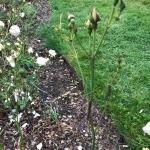
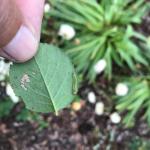 Pests/Problems: Once again, the major pest problem was and remains the spongy moth. It seemed that defoliation accelerated as the bulk of the caterpillar population advanced to the later and larger instar stages. Still there can be found caterpillars of no more than ¼ inch in length. In just the past week, many trees that had little infestation are now totally defoliated. The numbers of caterpillars is appalling, to put it bluntly. In addition to trees, roses and other shrubs are totally leafless. The caterpillars are found not only defoliating trees and shrubs but also herbaceous perennials. I’ve even witnessed one feeding on the leaves of irises. The heaviest infestations continue to be along the southwest corner bordering Connecticut, New York, and Berkshire County. That pattern continues north along the New York/ Berkshire border and up to and along the Vermont/ Berkshire border. Based on discussions with green industry folks located in the eastern areas of the County, there have been fewer, if any, issues with the caterpillars. Tawny Simisky will have more data on the caterpillar, including reports of virus and fungal infecting the caterpillars in the Insect Report below. Other pest observations this week include hemlock woolly adelgid on hemlocks in Monterey, rose slugs, lily leaf beetle adults and larvae, fourlined plant bug adults, and imported willow leaf beetle larvae. Diseases observed were: black spot on roses, powdery mildew on peony, anthracnose on maples, and leaf spot on Hamamelis. The first significant sighting of jumping worms was made this week. The worms were not yet fully mature.
Pests/Problems: Once again, the major pest problem was and remains the spongy moth. It seemed that defoliation accelerated as the bulk of the caterpillar population advanced to the later and larger instar stages. Still there can be found caterpillars of no more than ¼ inch in length. In just the past week, many trees that had little infestation are now totally defoliated. The numbers of caterpillars is appalling, to put it bluntly. In addition to trees, roses and other shrubs are totally leafless. The caterpillars are found not only defoliating trees and shrubs but also herbaceous perennials. I’ve even witnessed one feeding on the leaves of irises. The heaviest infestations continue to be along the southwest corner bordering Connecticut, New York, and Berkshire County. That pattern continues north along the New York/ Berkshire border and up to and along the Vermont/ Berkshire border. Based on discussions with green industry folks located in the eastern areas of the County, there have been fewer, if any, issues with the caterpillars. Tawny Simisky will have more data on the caterpillar, including reports of virus and fungal infecting the caterpillars in the Insect Report below. Other pest observations this week include hemlock woolly adelgid on hemlocks in Monterey, rose slugs, lily leaf beetle adults and larvae, fourlined plant bug adults, and imported willow leaf beetle larvae. Diseases observed were: black spot on roses, powdery mildew on peony, anthracnose on maples, and leaf spot on Hamamelis. The first significant sighting of jumping worms was made this week. The worms were not yet fully mature.
Regional Scouting Credits
- CAPE COD REGION - Russell Norton, Horticulture and Agriculture Educator with Cape Cod Cooperative Extension, reporting from Barnstable.
- SOUTHEAST REGION - Brian McMahon, Arborist, reporting from the Dighton area.
- NORTH SHORE REGION - Geoffrey Njue, Green Industry Specialist, UMass Extension, reporting from the Long Hill Reservation, Beverly.
- EAST REGION - Kit Ganshaw & Sue Pfeiffer, Horticulturists reporting from the Boston area.
- METRO WEST REGION – Julie Coop, Forester, Massachusetts Department of Conservation & Recreation, reporting from Acton.
- CENTRAL REGION - Mark Richardson, Director of Horticulture reporting from New England Botanic Garden at Tower Hill, Boylston.
- PIONEER VALLEY REGION - Nick Brazee, Plant Pathologist, UMass Extension Plant Diagnostic Lab, reporting from Amherst.
- BERKSHIRE REGION - Ron Kujawski, Horticultural Consultant, reporting from Great Barrington.
Woody Ornamentals
Diseases
Recent pests and pathogens of interest seen in the UMass Extension Plant Diagnostic Lab, a select few:
 Brown rot, caused by Monilinia fructicola, on Yoshino cherry (Prunus x yedoensis). The tree is roughly 50-years-old and resides in a residential landscape with full sun surrounded by lawn. It receives some supplemental irrigation from lawn sprinklers and has a large basal wound on the trunk. This spring, scattered shoot tip dieback was observed throughout the canopy. The sample had blighted shoot tips with collapsed flowers and leaves (see photo). The clear, lemon-shaped spores of Monilinia were abundant on the blighted plant parts. They occur in long chains and sometimes can be seen without magnification. They appear as a light brown to gray-colored, dusty coating on infected fruit, leaves and shoots. The lab has received several samples of brown rot on ornamental cherry this year.
Brown rot, caused by Monilinia fructicola, on Yoshino cherry (Prunus x yedoensis). The tree is roughly 50-years-old and resides in a residential landscape with full sun surrounded by lawn. It receives some supplemental irrigation from lawn sprinklers and has a large basal wound on the trunk. This spring, scattered shoot tip dieback was observed throughout the canopy. The sample had blighted shoot tips with collapsed flowers and leaves (see photo). The clear, lemon-shaped spores of Monilinia were abundant on the blighted plant parts. They occur in long chains and sometimes can be seen without magnification. They appear as a light brown to gray-colored, dusty coating on infected fruit, leaves and shoots. The lab has received several samples of brown rot on ornamental cherry this year.
 Minor infestation of the juniper sawfly (Monoctenus sp.) on Chinese juniper (Juniperus chinensis ‘Robusta Green’). The tree is roughly eight-years-old and was transplanted in fall of 2020. It receives full sun in well-drained, sandy-loam soils and is hand-watered as needed. A light infestation of the same pest was found on a neighboring Chinese juniper (J. chinensis ‘Kaizuka’) in 2021, so regular scouting has taken place this season. The larvae are small, well camouflaged, and best detected when viewed from below. Roughly a dozen have been found over the past week. When detected, they are easily hand-picked and terminated. While damage from this pest can be a problem at times, populations are usually small and not a threat to overall plant health.
Minor infestation of the juniper sawfly (Monoctenus sp.) on Chinese juniper (Juniperus chinensis ‘Robusta Green’). The tree is roughly eight-years-old and was transplanted in fall of 2020. It receives full sun in well-drained, sandy-loam soils and is hand-watered as needed. A light infestation of the same pest was found on a neighboring Chinese juniper (J. chinensis ‘Kaizuka’) in 2021, so regular scouting has taken place this season. The larvae are small, well camouflaged, and best detected when viewed from below. Roughly a dozen have been found over the past week. When detected, they are easily hand-picked and terminated. While damage from this pest can be a problem at times, populations are usually small and not a threat to overall plant health.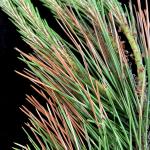
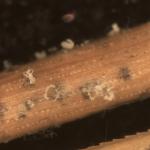
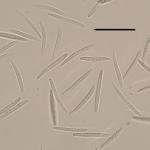 Needle tip blight of mugo pine (Pinus mugo), caused by Septorioides strobi. The tree receives partial sun in a residential landscape in soils composed of sand and clay with no supplemental water. This spring, the managing arborist observed the one-year-old needles (2021) browning at the tips. Needle tip blight is the pattern of damage often exhibited by pines (both hard and soft) infected by Septorioides. The fungus actively sporulates in early June, the time when the new shoots and needles are elongating. The current season’s needles are infected, but may not show symptoms until the following spring. When drought-stressed, the current season’s needles may show symptoms later in the summer. After a very brief incubation of the blighted needle tips, clear spore tendrils emerged from black pads of fungal tissue developing under the epidermis. Needle tip browning on two- and three-needle pines has been a common sight this season and Septorioides is likely responsible for much of the damage.
Needle tip blight of mugo pine (Pinus mugo), caused by Septorioides strobi. The tree receives partial sun in a residential landscape in soils composed of sand and clay with no supplemental water. This spring, the managing arborist observed the one-year-old needles (2021) browning at the tips. Needle tip blight is the pattern of damage often exhibited by pines (both hard and soft) infected by Septorioides. The fungus actively sporulates in early June, the time when the new shoots and needles are elongating. The current season’s needles are infected, but may not show symptoms until the following spring. When drought-stressed, the current season’s needles may show symptoms later in the summer. After a very brief incubation of the blighted needle tips, clear spore tendrils emerged from black pads of fungal tissue developing under the epidermis. Needle tip browning on two- and three-needle pines has been a common sight this season and Septorioides is likely responsible for much of the damage.- Oak anthracnose, caused by Ophiognomonia errabunda, on northern red oak (Quercus rubra). The tree is approximately 20-years-old and has been present at the site for 10 years. It resides in full sun with overhead irrigation in moderately-drained loam soils. During the spring season, the leaf margins began to brown and irregularly curl. The submitted leaves appeared undersized and distorted overall. The garden where the tree resides is regularly maintained and overhead sprinklers are believed to be directly spraying the foliage. The regular occurrence of free moisture on newly developing foliage would help create ideal conditions for oak anthracnose. Members of the white oak group (e.g. white and swamp white) are more susceptible, but red oaks are readily infected as well.
- Maple anthracnose, caused by Aureobasidium apocryptum, on sugar maple (Acer saccharum) and Japanese maple (A. palmatum ‘Tsuma-gaki’). The sugar maple is approximately 15-years-old and has been present at the site for many years. It experiences full sun with drip irrigation. This spring, the tree exhibited a sudden canopy dieback. It subsequently pushed some new shoots but has lost a significant amount of foliage. The submitted shoots had foliage that was blackened and collapsed. There was no evidence of any stem cankering or vascular staining from Verticillium. The Japanese maple is roughly 10-years-old and was transplanted one year ago. The landscape is well maintained with full sun and lawn irrigation providing some supplemental water. One branch showed symptoms of dieback and again, no evidence of cankering or wilt. The maple anthracnose pathogen was abundant on the blighted leaves and petioles.
Report by Nick Brazee, Plant Pathologist, UMass Extension Plant Diagnostic Lab, UMass Amherst.
Insects
An Update about Neonicotinoid Use in Massachusetts:
Beginning July 1, 2022 systemic insecticide active ingredients known as neonicotinoids will become state restricted use for tree and shrub uses in Massachusetts. If an individual works in the commercial industry (landscapers, arborists, etc.), then a Commercial Certification License is needed. (Example: Category 36 Commercial Certification License, Shade Trees & Ornamentals.) Someone can use a state or federal restricted use pesticide if they have a Commercial Applicators License as long as they are working under the direct supervision of someone with a Commercial Certification. Unlicensed or uncertified individuals will no longer be able to apply neonicotinoids to manage insect pests of trees and shrubs in Massachusetts.
More information is available, here: https://www.mass.gov/service-details/pesticide-newsupdates
Helpful Information from Taryn LaScola-Miner, Director, Crop and Pest Services Division of the MA Department of Agricultural Resources:
“As you know, products that contain neonicotinoids and have certain use patterns will have a classification change from General Use to Restricted Use on July 1, 2022. In order to help inform the manufacturers, dealers, sellers and applicators of which products will be changing from general use to restricted use, the Department has created the list of neonicotinoid products that currently are and will become restricted use beginning July 1st. You may find the list at the link below. Please note that this list is subject to change.
Additionally, MDAR is anticipating that there will be more of a need for companies to follow the Direct Supervision regulations with this change. Therefore, MDAR has updated its Direct Supervision Frequently Asked Questions document as well.
Although an email will be sent to all licensed applicators within the next few weeks as a final reminder of the change, please pass this information along to your members and customers as an effort to make this transition as smooth as possible. If you have any questions, please let me know. Thank you!”
List of Neonicotinoid Products: https://www.mass.gov/doc/list-of-neonicotinoid-pesticides/download
Direct Supervision Frequently Asked Questions: https://www.mass.gov/doc/direct-supervision-frequently-asked-questions-faq/download
Interesting Insects Reported Recently:
-
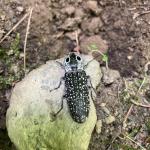 Eyed Click Beetle: Alaus oculatus is a native beetle in the family Elateridae (click beetles). Adults of this species have eye-like spots on the thorax that are outlined with white markings. May look similar to other species in this genus. Adults are commonly found on trees or under loose bark of logs and stumps infested with wood-boring beetle larvae. Commonly seen in spring and summer. Their larvae are predaceous, feeding on beetle larvae found in decaying stumps and logs. Found in the eastern United States and west to the Dakotas, Colorado, and Texas, as well as parts of Canada. This photo was taken by Joe Shoenfeld on 6/21/2022 in a garden in Conway, MA (Hampshire County). Neither the adults or larvae of this insect are considered pests, therefore they should be welcomed in the garden.
Eyed Click Beetle: Alaus oculatus is a native beetle in the family Elateridae (click beetles). Adults of this species have eye-like spots on the thorax that are outlined with white markings. May look similar to other species in this genus. Adults are commonly found on trees or under loose bark of logs and stumps infested with wood-boring beetle larvae. Commonly seen in spring and summer. Their larvae are predaceous, feeding on beetle larvae found in decaying stumps and logs. Found in the eastern United States and west to the Dakotas, Colorado, and Texas, as well as parts of Canada. This photo was taken by Joe Shoenfeld on 6/21/2022 in a garden in Conway, MA (Hampshire County). Neither the adults or larvae of this insect are considered pests, therefore they should be welcomed in the garden. -
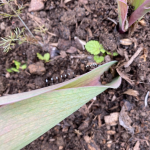 Lacewing Eggs: insects in the Order Neuroptera include the antlions, lacewings, and their allies. The eggs pictured here most likely belong to insects known as green lacewings, in the family Chrysopidae. Green lacewings lay tiny, white eggs on delicate, long stalks that are often found attached to leaves or twigs. Green lacewings are popularly known as beneficial insects, the adults and larvae of many species being predators of soft bodied pest insects such as aphids, but sometimes also larger insects, insect eggs, and pupae. (Hatching larvae may be so voracious that they will eat anything small enough, including siblings.) It is a good practice to learn what the different life stages of beneficial insects look like, including lacewing eggs, so that they can be preserved and encouraged in our landscapes. This photo was taken by Ed Kutchmanich on 6/1/2022 in Dover, MA (Norfolk County).
Lacewing Eggs: insects in the Order Neuroptera include the antlions, lacewings, and their allies. The eggs pictured here most likely belong to insects known as green lacewings, in the family Chrysopidae. Green lacewings lay tiny, white eggs on delicate, long stalks that are often found attached to leaves or twigs. Green lacewings are popularly known as beneficial insects, the adults and larvae of many species being predators of soft bodied pest insects such as aphids, but sometimes also larger insects, insect eggs, and pupae. (Hatching larvae may be so voracious that they will eat anything small enough, including siblings.) It is a good practice to learn what the different life stages of beneficial insects look like, including lacewing eggs, so that they can be preserved and encouraged in our landscapes. This photo was taken by Ed Kutchmanich on 6/1/2022 in Dover, MA (Norfolk County). -

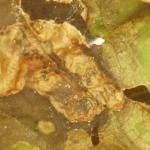
Oak Shothole Leafminer Damage: Not too long ago, UMass Extension reported about leaf damage being caused by a curious fly species (Japanagromyza viridula synonym Agromyza viridula) known as the oak shothole leafminer. In parts of Massachusetts in 2019, damage from this species was seen on ornamental oaks, combined with oak anthracnose activity. The photographs here show an additional side to the story. Professor of Plant Pathology and Nematology, Rob Wick (UMass), took photos of samples sent to him from Maine on 6/14/2022 of oak shothole leafminer damage on American chestnut. The photos show clearly the necrotic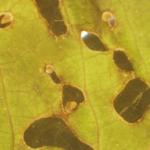
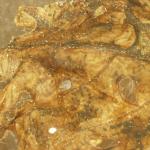 tab of tissue left behind by the early season (as leaves are expanding) feeding damage of the adult female flies who use their ovipositors to cut tiny holes in newly opening leaves to then lap up plant fluids. At the time the damage is caused, it is tiny (0.7 mm. wide) but expands as the leaves expand. The photos also show the frass-filled mines from the feeding larvae of this insect. While the damage has already been caused this year, it was interesting to see it on another host plant. Allison Kanoti, Maine Forest Service, reports that Maine saw oak shothole leafminer damage on oak and chestnut in 2019 in various locations in the state. Luckily, this insect is not typically too damaging to its host plants – but has certainly been noticeably active in recent years!
tab of tissue left behind by the early season (as leaves are expanding) feeding damage of the adult female flies who use their ovipositors to cut tiny holes in newly opening leaves to then lap up plant fluids. At the time the damage is caused, it is tiny (0.7 mm. wide) but expands as the leaves expand. The photos also show the frass-filled mines from the feeding larvae of this insect. While the damage has already been caused this year, it was interesting to see it on another host plant. Allison Kanoti, Maine Forest Service, reports that Maine saw oak shothole leafminer damage on oak and chestnut in 2019 in various locations in the state. Luckily, this insect is not typically too damaging to its host plants – but has certainly been noticeably active in recent years!
For more information about the activity of this insect in 2019 in MA, visit: https://ag.umass.edu/landscape/news/leaf-damage-to-oaks-caused-by-oak-shothole-leafminer-oak-anthracnose . For a great article regarding American chestnut as a host for oak shothole leafminer, check out this report from the Ohio State University Extension: https://bygl.osu.edu/index.php/node/1797 .
Insects and Other Arthropods
-
Deer Tick/Blacklegged Tick: Ixodes scapularis adults are active all winter and spring, as they typically are from October through May, and “quest” or search for hosts at any point when daytime temperatures are above freezing. Engorged females survive the winter and will lay 1,500+ eggs in the forest leaf litter beginning around Memorial Day (late May). Larval and nymphal deer ticks may be encountered at this time. Larvae are encountered in New England from roughly May through November, with peak risk reported in August. Nymphs are encountered from April through July with a peak risk reported in June in New England. Nymphs may also be encountered again in October and November. For images of all deer tick life stages, along with an outline of the diseases they carry, visit: https://web.uri.edu/tickencounter/species/blacklegged-tick/ .
Anyone working in the yard and garden should be aware that there is the potential to encounter deer ticks. The deer tick or blacklegged tick can transmit Lyme disease, human babesiosis, human anaplasmosis, and other diseases. Preventative activities, such as daily tick checks, wearing appropriate clothing, and permethrin treatments for clothing (according to label instructions) can aid in reducing the risk that a tick will become attached to your body. If a tick cannot attach and feed, it will not transmit disease. For more information about personal protective measures, visit: https://web.uri.edu/tickencounter/prevention/protect-yourself/
The Center for Agriculture, Food, and the Environment provides a list of potential tick identification and testing resources here: https://ag.umass.edu/resources/tick-testing-resources .
-
Mosquitoes: According to the Massachusetts Bureau of Infectious Disease and Laboratory Science and the Department of Public Health, there are at least 51 different species of mosquito found in Massachusetts. Mosquitoes belong to the Order Diptera (true flies) and the Family Culicidae (mosquitoes). As such, they undergo complete metamorphosis, and possess four major life stages: egg, larva, pupa, and adult. Adult mosquitoes are the only stage that flies and many female mosquitoes only live for 2 weeks (although the life cycle and timing will depend upon the species). Only female mosquitoes bite to take a blood meal, and this is so they can make eggs. Mosquitoes need water to lay their eggs in, so they are often found in wet or damp locations and around plants. Different species prefer different habitats. It is possible to be bitten by a mosquito at any time of the day, and again timing depends upon the species. Many are particularly active from just before dusk, through the night, and until dawn. Mosquito bites are not only itchy and annoying, but they can be associated with greater health risks. Certain mosquitoes vector pathogens that cause diseases such as West Nile virus (WNV) and eastern equine encephalitis (EEE).
For more information about mosquitoes in Massachusetts, visit: https://www.mass.gov/service-details/mosquitoes-in-massachusetts
There are ways to protect yourself against mosquitoes, including wearing long-sleeved shirts and long pants, keeping mosquitoes outside by using tight-fitting window and door screens, and using insect repellents as directed. Products containing the active ingredients DEET, permethrin, IR3535, picaridin, and oil of lemon eucalyptus provide protection against mosquitoes. Be aware that not all of these can be safely used on young children. Read and follow all label instructions for safety and proper use.
For more information about mosquito repellents, visit: https://www.mass.gov/service-details/mosquito-repellents and https://www.cdc.gov/mosquitoes/mosquito-bites/prevent-mosquito-bites.html
-
Wasps/Hornets: Many wasps are predators of other arthropods, including pest insects such as certain caterpillars that feed on trees and shrubs. Adult wasps hunt prey and bring it back to their nest where young are being reared, as food for the immature wasps. A common such example are the paper wasps (Polistes spp.) who rear their young on chewed up insects. They may be seen searching plants for caterpillars and other soft-bodied larvae to feed their young. Paper wasps can sting, and will defend their nests, which are open-celled paper nests that are not covered with a papery “envelope”. These open-celled nests may be seen hanging from eaves or other outdoor building structures. Aerial yellow jackets and hornets create large aerial nests that are covered with a papery shell or “envelope”. Common yellow jacket species include those in the genus Vespula. Dolichovespula maculata is commonly known as the baldfaced hornet, although it is not a true hornet. The European hornet (Vespa crabro) is three times the size of a yellow jacket and may be confused for the Asian giant hornet (Vespa mandarinia). The European hornet is known to Massachusetts, but the Asian giant hornet is not. If you are concerned that you have found or photographed an Asian giant hornet, please report it here: https://massnrc.org/pests/report.aspx . A helpful ID tool, although developed for Texas by the USDA, depicts common look-a-like species that we also have in MA that can be confused for the Asian giant hornet and is found here: https://agrilife.org/lubbock/files/2020/05/Asian_Giant_Hornet_Look-alikes_101_Xanthe_Shirley.pdf . Paper wasps and aerial yellowjackets overwinter as fertilized females (queens) and a single female produces a new nest annually in the late spring. Queens start new nests, lay eggs, and rear new wasps to assist in colony/nest development. Nests are abandoned at the end of the season. Some people are allergic to stinging insects, so care should be taken around wasp/hornet nests. Unlike the European honeybee (Apis mellifera), wasps and hornets do not have barbed stingers, and therefore can sting repeatedly when defending their nests. It is best to avoid them, and if that cannot be done and assistance is needed to remove them, consult a professional.
Woody ornamental insect and non-insect arthropod pests to consider, a selected few:
Invasive Insects & Other Organisms Update:
-

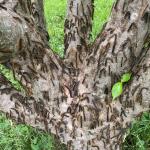
 Spongy Moth: Lymantria dispar egg hatch was first reported to UMass Extension by arborists in Great Barrington, MA on 5/5/2022. Since then, the MA Department of Conservation and Recreation has seen activity in parts of Williamstown, Hancock, Pittsfield, Erving, and Wendell, MA (reported on 5/12/2022). Additionally, arborists report caterpillar feeding activity in Sheffield, MA. At that location, heavy feeding has been observed on apples (with variation depending on variety) and oak as well as light feeding on Prunus spp., Crataegus spp., and Tilia americana. Light to no defoliation was observed in Sheffield, MA on mulberry, Katsura, hydrangea, pear, Cercis canadensis, and Viburnum nudum at that location, on 5/12/2022. By now, professionals and property owners are reporting and suffering heavy defoliation to shade trees and ornamentals from spongy moth, particularly in southern areas of Berkshire County bordering New York. Scouts and arborists report extensive feeding from caterpillars in certain areas. (See Berkshire Region Report above.) Caterpillars may be seen on host plants or crawling on other surfaces nearby. An arborist’s report from June 18, 2022 noted heavy feeding on oak, apple, birch, beech, maple, and willow in certain parts of southern Berkshire County. Video footage of extremely prolific numbers of caterpillars was shared with UMass Extension from 6/22/2022 on the Canaan, NY/Sheffield, MA border.
Spongy Moth: Lymantria dispar egg hatch was first reported to UMass Extension by arborists in Great Barrington, MA on 5/5/2022. Since then, the MA Department of Conservation and Recreation has seen activity in parts of Williamstown, Hancock, Pittsfield, Erving, and Wendell, MA (reported on 5/12/2022). Additionally, arborists report caterpillar feeding activity in Sheffield, MA. At that location, heavy feeding has been observed on apples (with variation depending on variety) and oak as well as light feeding on Prunus spp., Crataegus spp., and Tilia americana. Light to no defoliation was observed in Sheffield, MA on mulberry, Katsura, hydrangea, pear, Cercis canadensis, and Viburnum nudum at that location, on 5/12/2022. By now, professionals and property owners are reporting and suffering heavy defoliation to shade trees and ornamentals from spongy moth, particularly in southern areas of Berkshire County bordering New York. Scouts and arborists report extensive feeding from caterpillars in certain areas. (See Berkshire Region Report above.) Caterpillars may be seen on host plants or crawling on other surfaces nearby. An arborist’s report from June 18, 2022 noted heavy feeding on oak, apple, birch, beech, maple, and willow in certain parts of southern Berkshire County. Video footage of extremely prolific numbers of caterpillars was shared with UMass Extension from 6/22/2022 on the Canaan, NY/Sheffield, MA border.
At this time of year, it is typical for spongy moth caterpillars to be nearing pupation, which luckily means that feeding for 2022 in Berkshire County will be coming to an end. Pupation typically occurs by the first two weeks in July, but may start in the last week of June. Recent reports indicate that caterpillars may be in different instars (sizes) at this time. This could be due to differences in location, but also due to parasitism by biological control enemies of the spongy moth. Hopefully at least some of those smaller-than-normal caterpillars will not survive to pupation.
At this time, the vast majority of spongy moth caterpillars will be over ¾ inch in length, meaning that it is too late to manage them with Bacillus thuringiensis Kurstaki (Btk). In fact, because most of their defoliation has been done at this point, and pupation is right around the corner, chemical management of these caterpillars may not help ornamental plants at this time in the season. Additionally, chemical management of larger spongy moth caterpillars (2-3 inches in length) can be very difficult.
So in what can we hope? The good news: activity from the NPV virus and the spongy moth caterpillar killing fungus, Entomophaga maimaiga, has been reported in Berkshire County! Fungus and virus killed caterpillars have been reported in Williamstown, MA (6/21/2022) and Sheffield, MA (6/16/2022). Fungus-killed caterpillars will appear shriveled and dried, typically hanging vertically in a straight line on the trunks and branches of their hosts, or other surfaces nearby. Virus killed caterpillars tend to droop in an inverted-V shape and are often moist/juicy in appearance. The fungus and virus will hopefully help reduce the population of spongy moths in Berkshire County for next year – although time will tell. Continue to monitor for pupation and emerging adult male and female moths who will mate and begin laying their tan, spongy egg masses in July. Overwintering egg masses will provide the population for next year, if caterpillars survive to pupate into adults in 2022.
The bottom line: do not panic. The spongy moth (Lymantria dispar) has been in Massachusetts since the 1860’s and periodic outbreaks have occurred since then. Due to the fungus, virus, and other natural enemies, the populations will crash again.
Why did the common name for Lymantria dispar change recently? More information is available here: https://entsoc.org/news/press-releases/spongy-moth-approved-new-common-name-lymantria-dispar
To learn more about the life cycle and natural enemies of this insect, including the NPV virus and Entomophaga maimaiga,
visit: https://ag.umass.edu/landscape/education-events/insectxaminer .
-
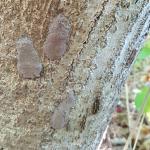 Spotted Lanternfly: (Lycorma delicatula, SLF) is a non-native, invasive insect that feeds on over 103 species of plants, including many trees and shrubs that are important in our landscapes.
Spotted Lanternfly: (Lycorma delicatula, SLF) is a non-native, invasive insect that feeds on over 103 species of plants, including many trees and shrubs that are important in our landscapes.
The MA Department of Agricultural Resources (MDAR) recently published the following press release, urging professionals and the general public to search all nursery stock, particularly maples and crabapples, purchased this year for spotted lanternfly egg masses: https://www.mass.gov/news/state-agricultural-officials-ask-public-to-be-on-alert-for-hatching-of-invasive-spotted-lanternfly-eggs . In particular, the press release warns:
“MDAR recently received reports that nursery stock from SLF-infested areas may have been sent to Massachusetts growers. Due to this, anyone who has recently purchased trees or shrubs or had them planted on their property, particularly maple or crabapple trees, is being asked to inspect the trunk and branches to ensure there are no SLF egg masses or any hitchhiking nymphs, and to report any finds to MDAR. Landscapers and plant nurseries are also being reminded to stay on the lookout for this pest.”
Currently, the only established populations of spotted lanternfly in Massachusetts are in a small area in both Fitchburg and Shrewsbury, MA. Therefore, there is no reason to be preemptively treating for this insect in other areas of Massachusetts. If you suspect you have found spotted lanternfly in additional locations, please report it immediately to MDAR here: https://massnrc.org/pests/slfreport.aspx . If you are living and working in the Fitchburg and Shrewsbury areas, please be vigilant and continue to report anything suspicious.
For More Information:
From UMass Extension:
Check out the InsectXaminer Episode about spotted lanternfly adults and egg masses! Available here: https://ag.umass.edu/landscape/education-events/insectxaminer
Fact Sheet: https://ag.umass.edu/landscape/fact-sheets/spotted-lanternfly
From the MA Department of Agricultural Resources:
Fact Sheet and Map of Locations in MA: https://massnrc.org/pests/pestFAQsheets/spottedlanternfly.html
-
Asian Longhorned Beetle: (Anoplophora glabripennis, ALB) Look for signs of an ALB infestation which include perfectly round exit holes (about the size of a dime), shallow oval or round scars in the bark where a female has chewed an egg site, or sawdust-like frass (excrement) on the ground nearby host trees or caught in between branches. Be advised that other, native insects may create perfectly round exit holes or sawdust-like frass, which can be confused with signs of ALB activity.
The regulated area for Asian longhorned beetle is 110 square miles encompassing Worcester, Shrewsbury, Boylston, West Boylston, and parts of Holden and Auburn. If you believe you have seen damage caused by this insect, such as exit holes or egg sites, on susceptible host trees like maple, please call the Asian Longhorned Beetle Eradication Program office in Worcester, MA at 508-852-8090 or toll free at 1-866-702-9938.
To report an Asian longhorned beetle find online or compare it to common insect look-alikes, visit: http://massnrc.org/pests/albreport.aspx or https://www.aphis.usda.gov/pests-diseases/alb/report .
-
Browntail Moth: Euproctis chrysorrhoea is an invasive insect originating from Europe and first detected in the US in Somerville, MA in 1897. Currently, browntail moth is limited to a small portion of eastern Massachusetts, particularly areas near the coast. Report suspected browntail moth life stages here: https://massnrc.org/pests/pestreports.htm . Due to a persistent outbreak of this insect in Maine since approximately 2016, it is a good idea for us to again familiarize ourselves with this pest. (For more information and the latest updates about the status of this insect in Maine, visit: https://www.maine.gov/dacf/mfs/forest_health/invasive_threats/browntail_moth_info.htm .)
Caution: hairs found on the caterpillar and pupal life stages of this insect can cause a rash similar to poison ivy. Some individuals are very sensitive to browntail moth hairs and may also experience allergic reaction. The chance of interacting with browntail moth hairs increases between May and July, although they could be a problem at any time of year.
The larval or caterpillar stage of this insect is present from August until the following June (spending the winter in webs they create on the tips of host plant twigs). In the fall, groups of caterpillars are found creating webs around a tightly wrapped leaf (covered in bright white silk) where they will overwinter in groups of 25-400. These 2-4 inch long webs can be found on the ends of branches often on apple or red oak. As soon as leaves begin to open in the spring (usually by April), the caterpillars will crawl from their webs to feed on the new leaves. Caterpillars are fully grown around June and spin cocoons in which they pupate. These cocoons are also full of the irritating hairs and should be dealt with extreme caution. Adult moths emerge in July and females lay eggs on the undersides of leaves in masses of 200-400, covering them with hairs from their bodies. (Adults do not typically cause skin rashes.) Eggs hatch around August and September and larvae feed shortly before forming their overwintering webs.
The primary concern with this insect are the poisonous hairs found on the caterpillars. Contact with the caterpillar or its hairs can cause a rash similar to poison ivy in susceptible individuals. If hairs break off and blow around in the wind, they can cause difficulty breathing and headaches. While this insect can act as a defoliator in the larval stage, feeding on the leaves of many deciduous trees and shrubs, this activity may be secondary to concerns about public health risks. Care should be taken to avoid places infested with these caterpillars, exposed skin or clothing should be washed, and the appropriate PPE should be worn if working with these insects. Consult your physician if you have a reaction to the browntail moth.
-
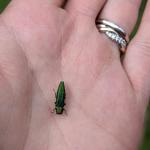 Emerald Ash Borer: (Agrilus planipennis, EAB) has been detected in at least 11 out of the 14 counties in Massachusetts. A map of these locations across the state may be found here: https://ag.umass.edu/fact-sheets/emerald-ash-borer . Additional information about this insect is provided by the MA Department of Conservation and Recreation, here:https://arcg.is/j8TiD .
Emerald Ash Borer: (Agrilus planipennis, EAB) has been detected in at least 11 out of the 14 counties in Massachusetts. A map of these locations across the state may be found here: https://ag.umass.edu/fact-sheets/emerald-ash-borer . Additional information about this insect is provided by the MA Department of Conservation and Recreation, here:https://arcg.is/j8TiD .
This wood-boring beetle readily attacks ash (Fraxinus spp.) including white, green, and black ash and has also been found developing in white fringe tree (Chionanthus virginicus) and has been reported in cultivated olive (Olea europaea). Signs of an EAB infested tree may include D-shaped exit holes in the bark (from adult emergence), “blonding” or lighter coloration of the ash bark from woodpecker feeding (chipping away of the bark as they search for larvae beneath), and serpentine galleries visible through splits in the bark, from larval feeding beneath. It is interesting to note that woodpeckers are capable of eating 30-95% of the emerald ash borer larvae found in a single tree (Murphy et al. 2018). Unfortunately, despite high predation rates, EAB populations continue to grow. However, there is hope that biological control efforts will eventually catch up with the emerald ash borer population and preserve some of our native ash tree species for the future. For an update about the progress of the biological control of emerald ash borer, visit Dr. Joseph Elkinton’s archived 2022 webinar.
-
Jumping Worms: Amynthas spp. earthworms, collectively referred to as “jumping or crazy or snake” worms, overwinter as eggs in tiny, mustard-seed sized cocoons found in the soil or other substrate (ex. compost) that are impossible to remove. The first adults appear in the end of May – June, but the numbers are low and infestations are rarely noticed at that time. It is easy to misidentify earthworms if only immatures found. By August and September, this is when most observations of fully mature jumping worms occur. At that time, snake worms become quite abundant, infestations become very noticeable, and may cause a lot of concern for property owners and managers.
For More Information:
UMass Extension Fact Sheets:
Earthworms in Massachusetts – History, Concerns, and Benefits: https://ag.umass.edu/landscape/fact-sheets/earthworms-in-massachusetts-history-concerns-benefits
Jumping/Crazy/Snake Worms – Amynthas spp.:
https://ag.umass.edu/landscape/fact-sheets/jumpingcrazysnake-worms-amynthas-spp
A Summary of the Information Shared at UMass Extension’s Jumping Worm Conference in January 2022:
https://ag.umass.edu/news-events/highlights/jumping-worms-conference
Tree & Shrub Insect Pests, Continued:
-
Arborvitae Leafminer: In New England and eastern Canada, four species of leafminers are known to infest arborvitae. These include Argyresthia thuiella, A. freyella, A. aureoargentella, and Coleotechnites thujaella. The arborvitae leafminer, A. thuiella, is the most abundant of these and has the greatest known range when compared to the others. (It is also found in the Mid-Atlantic States and as far west as Missouri). Moths of this species appear from mid-June to mid-July and lay their eggs. The damage caused by all of these species is nearly identical. Trees, however, have been reported to lose up to 80% of their foliage due to arborvitae leafminer and still survive. At least 27 species of parasites have been reported as natural enemies of arborvitae leafminers, the most significant of which may be a parasitic wasp (Pentacnemus bucculatricis). Arborvitae leafminer damage causes the tips of shoots and foliage to turn yellow and brown. If infestations are light, prune out infested tips.
-
Azalea Sawflies: There are a few species of sawflies that impact azaleas. Johnson and Lyon's Insects that Feed on Trees and Shrubs mentions three of them. Amauronematus azaleae was first reported in New Hampshire in 1895 and is likely found in most of New England. Adults of this species are black with some white markings and wasp-like. Generally green larvae feed mostly on mollis hybrid azaleas. Remember, sawfly caterpillars have at least enough abdominal prolegs to spell “sawfly” (so 6 or more prolegs). Adults are present in May, and females lay their eggs and then larvae hatch and feed through the end of June. There is one generation per year. Nematus lipovskyi has been reared from swamp azalea (Rhododendron viscosum). Adults of that species have been collected in April (in states to the south) and May (in New England) and larval feeding is predominantly in late April and May in Virginia and June in New England. One generation of this species occurs per year, and most mollis hybrid azaleas can be impacted. A third species, Arge clavicornis, is found as an adult in July and lays its eggs in leaf edges in rows. Larvae are present in August and September. Remember, Bacillus thuringiensis Kurstaki does not manage sawflies.
-
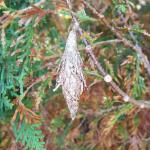 Bagworm: Thyridopteryx ephemeraeformis is a native species of moth whose larvae construct bag-like coverings over themselves with host plant leaves and twigs. At this time, any overwintered bagworm eggs will have hatched and caterpillars will have begun to feed. Look for caterpillars with cone-like coverings of chewed up leaves, bark, and other plant parts. Common bagworm may be found on evergreen and deciduous host plants. More information can be found here: https://ag.umass.edu/landscape/fact-sheets/bagworm .
Bagworm: Thyridopteryx ephemeraeformis is a native species of moth whose larvae construct bag-like coverings over themselves with host plant leaves and twigs. At this time, any overwintered bagworm eggs will have hatched and caterpillars will have begun to feed. Look for caterpillars with cone-like coverings of chewed up leaves, bark, and other plant parts. Common bagworm may be found on evergreen and deciduous host plants. More information can be found here: https://ag.umass.edu/landscape/fact-sheets/bagworm . - Cottony Taxus Scale: Pulvinaria floccifera, also referred to as the cottony camellia scale, utilizes such hosts as taxus, camellia, holly, hydrangea, Japanese maple, euonymus, magnolia, and jasmine, among others. Females have laid the long, narrow, white and fluted egg sac that makes them much more noticeable. Eggs will hatch over an extended period of 6 weeks and crawlers may be treated between 802-1388 GDD’s. This insect can cause the host to appear off-color. They also produce honeydew which promotes sooty mold growth. Dieback is not common with this insect. Target the underside of the foliage. Horticultural oil, neem oil, and insecticidal soaps may be used to manage these soft scales. Reduced risk options help preserve natural enemies.
-
Dogwood Borer: Synanthedon scitula is a species of clearwing moth whose larvae bore not only into dogwood (Cornus), but hosts also include flowering cherry, chestnut, apple, mountain ash, hickory, pecan, willow, birch, bayberry, oak, hazel, myrtle, and others. Kousa dogwood appear to be resistant to this species. Signs include the sloughing of loose bark, brown frass, particularly near bark cracks and wounds, dead branches, and adventitious growth. The timing of adult emergence can be expected when dogwood flower petals are dropping and weigela begins to bloom. Adult moth flights continue from then until September. Emergence in some hosts (ex. apple) appears to be delayed, but this differs depending upon the location in this insect’s range. Eggs are laid singly, or in small groups, on smooth and rough bark. Female moths preferentially lay eggs near wounded bark. After hatch, larvae wander until they find a suitable entrance point into the bark. This includes wounds, scars, or branch crotches. This insect may also be found in twig galls caused by other insects or fungi. Larvae feed on phloem and cambium. Fully grown larvae are white with a light brown head and are approx. ½ inch long. Pheromone traps and lures are useful for determining the timing of adult moth emergence and subsequent management.
-
Dogwood Sawfly: Macremphytus tarsatus has one generation per year. The larvae of the dogwood sawfly overwinter in decaying wood and occasionally compromised structural timber. An overwintering "cell" is created in this soft wood. Pupation occurs in the springtime and adults can take a lengthy time to emerge, roughly between late May and July. 100+ eggs are laid in groups on the underside of leaves. Eggs hatch and the larvae feed gregariously, initially skeletonizing leaves. As the caterpillars grow in size, they are capable of eating the entire leaf with the exception of the midvein. Larval appearance varies greatly throughout instars, so much so that one might mistake them for multiple species. Early instars are translucent and yellow, but as the caterpillars grow they develop black spots (over yellow) and become covered in a white powder-like material. Larvae and their shed skins may resemble bird droppings. Full grown larvae begin to wander in search of a suitable overwintering location. Rotting wood lying on the ground is preferred for this. Foliage of dogwood, especially gray dogwood (Cornus racemosa) may be impacted. Skeletonizes leaves at first, then eats all but the midvein.
- Euonymus Caterpillar: Yponomeuta cagnagella is of European origin and widespread in distribution throughout Europe. It was first reported in North America in Ontario in 1967. The euonymus caterpillars (larvae) feed in groups and envelop the foliage of the host plant in webs as they feed. Hosts include: Euonymus europaeus (tree form), E. kiautschovicus, E. alatus, and E. japonicus. Mature caterpillars are just under an inch in length, creamy yellow-gray in color with black spots and a black head capsule. By late June, these larvae pupate in white, oval-shaped cocoons which are typically oriented together vertically either on host plants or non-hosts in the area. Cocoons can be found in cracks and crevices, or webbed together leaves. The adult moth emerges in late June in most locations. The adult female secretes a gummy substance over her eggs which will harden, making them even more difficult to see. Eggs hatch by mid-August, at which time the tiny larvae prepare to overwinter beneath their eggshell-like covering. These larvae are inactive until the following year, when caterpillars group together to feed on newly emerging leaves, creating a mess of webs as they feed. There is one generation per year. Plants may be partially or entirely defoliated. Management of young, actively feeding caterpillars with Bacillus thuringiensis is possible if deemed necessary, however many species of Euonymus are considered invasive themselves.
Check out Episode 3 of InsectXaminer to see the euonymus caterpillar in action and learn more about its life cycle: https://ag.umass.edu/landscape/education-events/insectxaminer
- European Elm Scale: Gossyparia spuria is a type of felt scale. First noted in New York in 1884, this non-native scale is now widespread in North America and is found on native and European elms, but also rarely on hackberry and Zelkova. This insect can cause yellowing of foliage, premature leaf drop, and eventually dieback on its host. Honeydew and thus sooty mold are produced. By the end of June, females will lay eggs that hatch into bright yellow crawlers, which will disperse to the midrib and leaf veins on the underside of elm leaves where they will remain to feed. Crawlers are tiny and magnification is necessary to observe. Natural enemies such as parasitic wasps and predatory insects have been reported as successful in managing this insect.
- Fall Webworm: Hyphantria cunea is native to North America and Mexico. It is now considered a world-wide pest, as it has spread throughout much of Europe and Asia. (For example, it was introduced accidentally into Hungary from North America in the 1940’s.) Hosts include nearly all shade, fruit, and ornamental trees except conifers. In the USA, at least 88 species of trees are hosts for these insects, while in Europe at least 230 species are impacted. In the past history of this pest, it was once thought that the fall webworm was a two-species complex. It is now thought that H. cunea has two color morphs – one black headed and one red headed. These two color forms differ not only in the coloration of the caterpillars and the adults, but also in their behaviors. Caterpillars may go through at least 11 molts, each stage occurring within a silken web they produce over the host. When alarmed, all caterpillars in the group will move in unison in jerking motions that may be a mechanism for self-defense. Depending upon the location and climate, 1-4 generations of fall webworm can occur per year. Fall webworm adult moths lay eggs on the underside of the leaves of host plants in the spring. These eggs hatch in late June or early July depending on climate. Young larvae feed together in groups on the undersides of leaves, first skeletonizing the leaf and then enveloping other leaves and eventually entire branches within their webs. Webs are typically found on the terminal ends of branches. All caterpillar activity occurs within this tent, which becomes filled with leaf fragments, cast skins, and frass. Fully grown larvae then wander from the webs and pupate in protected areas such as the leaf litter where they will remain for the winter. Adult fall webworm moths emerge the following spring/early summer to start the cycle over again. 50+ species of parasites and 36+ species of predators are known to attack fall webworm in North America. Fall webworms typically do not cause extensive damage to their hosts. Nests may be an aesthetic issue for some. If in reach, small fall webworm webs may be pruned out of trees and shrubs and destroyed. Do not set fire to H. cunea webs when they are still attached to the host plant.
 Imported Willow Leaf Beetle: Plagiodera versicolora adult beetles overwinter near susceptible hosts. Adult beetles will chew holes and notches in the leaves of willow once they become available. Females lay yellow eggs in clusters on the undersides of leaves. Larvae are slug-like and bluish-green in color. They will feed in clusters and skeletonize the leaves. Most plants can tolerate multiple years of feeding from this insect, and foliage will appear brown. Repeated yearly feeding can occasionally be an issue, in which case management of the young larvae may be necessary. Take care with treatment in areas near water.
Imported Willow Leaf Beetle: Plagiodera versicolora adult beetles overwinter near susceptible hosts. Adult beetles will chew holes and notches in the leaves of willow once they become available. Females lay yellow eggs in clusters on the undersides of leaves. Larvae are slug-like and bluish-green in color. They will feed in clusters and skeletonize the leaves. Most plants can tolerate multiple years of feeding from this insect, and foliage will appear brown. Repeated yearly feeding can occasionally be an issue, in which case management of the young larvae may be necessary. Take care with treatment in areas near water.
Check out Episode 4 of InsectXaminer to see the imported willow leaf beetle in action: https://ag.umass.edu/landscape/education-events/insectxaminer
- Lacebugs: Stephanitis spp. lacebugs such as S. pyriodes can cause severe injury to azalea foliage. S. rhododendri can be common on rhododendron and mountain laurel. S. takeyai has been found developing on Japanese andromeda, leucothoe, styrax, and willow. Stephanitis spp. lace bug activity should be monitored through September. Before populations become too large, treat with a summer rate horticultural oil spray as needed. Be sure to target the undersides of the foliage in order to get proper coverage of the insects. Certain azalea and andromeda cultivars may be less preferred by lace bugs.
-
Lilac Borer: Podosesia syringae is a clearwing moth pest of lilac, privet, fringetree, and ash. (It is also known as the ash borer, not to be confused with the emerald ash borer.) Adults mimic paper wasps. Larvae are wood-boring, and signs and symptoms include branch dieback, holes, and occasionally, sawdust-like frass accumulated on bark. Larvae bore into stems, trunks, and branches, chewing an irregularly shaped entrance hole. Peak adult moth flights may occur in the northern portion of this insect’s range in June and are usually over by August 1st. Pheromone traps can be used to time adult emergence. Adult females lay flattened, oval, and tan eggs that are deposited singly or in clusters on bark crevices, ridges, and sometimes smooth bark; but usually laid in or near wounds in the bark. On average, 395 eggs are laid by each female. After hatch, larvae chew into the bark and feed laterally and then vertically in phloem tissue. Larvae overwinter in tunnels in the final instar and resume feeding in the spring. Adults emerge through a round exit hole (4-5 mm. in diameter). This insect may be targeted between 200-299 GDD’s, base 50°F.
-
Magnolia Scale: Neolecanium cornuparvum overwinters as first instar nymphs which are elliptical, and dark slate gray in color and can usually be found on the undersides of 1 and 2 year old twigs. Nymphs may molt by late April or May and again by early June at which time the scales may be purple in color. Eventually nymphs secrete a white powdery layer of wax over their bodies.
-
Taxus Mealybug: Dysmicoccus wistariae will produce honeydew and lead to sooty mold growth, yellowing of needles, and sparsely foliated plants. Eventual dieback may be possible. This species is commonly associated with taxus in New England, but can be occasionally found on dogwood, rhododendron, Prunus spp., maple, andromeda, and crabapple. These mealybugs are found on stems and branches and particularly like to congregate at branch crotches. Taxus mealybug feeds in the inner bark tissue of the trunk and branches. Adult females are present from June to August and give birth to living young in the summer. Immatures overwinter. A single generation may occur per year in New England, but areas to the south can have multiple generations of this insect. Management may be targeted between 246-618 GDD’s, base 50°F. Horticultural oil and neem oil may be used.
-
Viburnum Leaf Beetle: Pyrrhalta viburni is a beetle in the family Chrysomelidae that is native to Europe, but was found in Massachusetts in 2004. This beetle feeds exclusively on many different species of viburnum, which includes, but is not limited to, susceptible plants such as V. dentatum, V. nudum, V. opulus, V. propinquum, and V. rafinesquianum. This is the time of year that viburnum leaf beetle larvae, when they are approximately 10-11 mm. long, crawl down the shrub, enter the soil, and pupate. Once this occurs, feeding stops (pauses) until the adult beetles emerge in early July. At that time, adult beetles will resume feeding, mate, and the females will lay their eggs in pits they chew at the ends of twigs. Eggs overwinter. Adults may also migrate to previously not yet infested plants. Some viburnum have been observed to have varying levels of resistance to this insect, including but not limited to V. bodnantense, V. carlesii, V. davidii, V. plicatum, V. rhytidophyllum, V. setigerum, and V. sieboldii. More information about viburnum leaf beetle may be found at http://www.hort.cornell.edu/vlb/ .
-

 White Satin Moth: Leucoma salicis has again been reported from Beartown State Forest (Berkshire County) on 6/8/2022 by the Massachusetts Department of Conservation and Recreation, Forest Health Program (photos courtesy of Eric Reynolds). This is the same location that caterpillars of this species were seen defoliating their hosts in 2020 and 2021.
White Satin Moth: Leucoma salicis has again been reported from Beartown State Forest (Berkshire County) on 6/8/2022 by the Massachusetts Department of Conservation and Recreation, Forest Health Program (photos courtesy of Eric Reynolds). This is the same location that caterpillars of this species were seen defoliating their hosts in 2020 and 2021.
The caterpillars of this species have a unique color pattern, which helps us distinguish them from others. The dorsal (back) side of the caterpillar is marked with 10-11 white, intersegmental spots as well as paired, red “setal warts”. The sides of the caterpillars are blueish gray. These caterpillars are known to the edges of waterways, woodlands, and forests from Canada to northwestern Connecticut and central New York. One generation occurs per year with mature caterpillars known in May and June. Host plants include aspen, poplar, and willow, the leaves of which are fed upon by the caterpillars of this species.
The white satin moth was introduced from Europe and first reported between Boston, MA and Hampton, New Hampshire in 1920. This insect is said to overwinter in the third instar (caterpillars pass through seven instars), either individually or in small groups. In the springtime, caterpillars leave their areas of hibernation to feed on nearby leaves. Caterpillars spin a thin cocoon between leaves or between exfoliating or thick bark crevices. Pupae are dark brown/black and often in a thin, loose silken sack. Pupae also sport brightly colored, yellow setae (hairs) that make them quite attractive. Pupation begins by the end of June. Shortly thereafter, moths emerge and females lay egg masses covered in a frothy, white material from July – mid-August. Eggs hatch sometime in August, and larvae will conduct feeding in August and September.
While caterpillars of this species are not noted to be of particular concern with regard to causing allergic reactions such as dermatitis, they are a type of tussock moth and do possess hairs, so they should not be handled and should be approached with caution particularly by sensitive individuals.
-
White Spotted Pine Sawyer (WSPS): Monochamus scutellatus adults can emerge in late May throughout July, depending on local temperatures. This is a native insect in Massachusetts and is usually not a pest. Larvae develop in weakened or recently dead conifers, particularly eastern white pine (Pinus strobus). However, the white spotted pine sawyer looks very similar to the invasive Asian Longhorned Beetle, Anoplophora glabripennis, ALB. ALB adults do not emerge in Massachusetts until July and August. Beginning in July, look for the key difference between WSPS and ALB adults, which is a white spot in the top center of the wing covers (the scutellum) on the back of the beetle. White spotted pine sawyer will have this white spot, whereas Asian longhorned beetle will not. Both insects can have other white spots on the rest of their wing covers; however, the difference in the color of the scutellum is a key characteristic. See the Asian longhorned beetle entry above for more information about that non-native insect.
Concerned that you may have found an invasive insect or suspicious damage caused by one? Need to report a pest sighting? If so, please visit the Massachusetts Introduced Pests Outreach Project: http://massnrc.org/pests/pestreports.htm .
Reported by Tawny Simisky, Extension Entomologist, UMass Extension Landscape, Nursery, & Urban Forestry Program
Additional Resources
Pesticide License Exams - The MA Dept. of Agricultural Resources (MDAR) is now holding exams online. For more information and how to register, go to: https://www.mass.gov/pesticide-examination-and-licensing.
To receive immediate notification when the next Landscape Message update is posted, join our e-mail list or follow us on Facebook.
For a complete listing of upcoming events, see our upcoming educational events https://ag.umass.edu/landscape/upcoming-events
For commercial growers of greenhouse crops and flowers - Check out UMass Extension's Greenhouse Update website
For professional turf managers - Check out Turf Management Updates
For home gardeners and garden retailers - Check out our home lawn and garden resources.
Diagnostic Services
UMass Laboratory Diagnoses Landscape and Turf Problems - The UMass Extension Plant Diagnostic Lab is available to serve commercial landscape contractors, turf managers, arborists, nurseries and other green industry professionals. It provides woody plant and turf disease analysis, woody plant and turf insect identification, turfgrass identification, weed identification, and offers a report of pest management strategies that are research based, economically sound and environmentally appropriate for the situation. Accurate diagnosis for a turf or landscape problem can often eliminate or reduce the need for pesticide use. For sampling procedures, detailed submission instructions and a list of fees, see Plant Diagnostic Laboratory
Soil and Plant Nutrient Testing - The University of Massachusetts Soil and Plant Nutrient Testing Laboratory is located on the campus of The University of Massachusetts at Amherst. Testing services are available to all. The lab provides test results and recommendations that lead to the wise and economical use of soils and soil amendments. For more information, including current turn-around times, visit the UMass Soil and Plant Nutrient Testing Laboratory web site. The lab is currently accepting new orders for Routine Soil Analysis (including optional Organic Matter, Soluble Salts, and Nitrate testing), Particle Size Analysis, Pre-Sidedress Nitrate (PSNT), and Soilless Media (no other types of soil analyses available at this time). Turnaround time: Please plan for the fact that date of receipt in the lab is affected by weekends, holidays, shipping time, and time for UMass Campus Mail to deliver samples to the lab.
Tick Testing - The UMass Center for Agriculture, Food, and the Environment provides a list of potential tick identification and testing options at: https://ag.umass.edu/resources/tick-testing-resources.
Acknowledgements: UMass Extension gratefully acknowledges the support of the following funding sources for the production of the Landscape Message –
- The Massachusetts Nursery and Landscape Association Fund
- The Massachusetts Department of Conservation and Recreation, Award #ISADCR28219926UMA22A
- Stakeholders like you! The Landscape Message is partially supported by educational program user fees.


